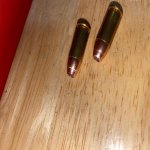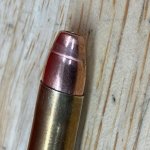I have a Hornady 9mm seating die that leaves marks on my bullets when they are seated. This is on a Dillon 650 and the case mouths are flared slightly by the case powder dropper (just enough to allow the base of the bullet to rest there in the seating position)


I took the die apart and looked at the seating stem and dont see anything abnormal. I think this issue is a component of the lip of the seating stem being focused on a small area on the bullet and causing a mark as it applies enough force to squeeze the bullet into the case.
The seating die is quite straight and as mentioned only a very small / thin area makes contact with the bullet, if the die were shaped like the bullet it would speed this force across more surface area which would eliminate the marks (I know it isn't really possible for the manufacturer to do this due to the large range of sizes / shapes of bullets on the market)
I have read about using lapping compound or similar and using a bullet in a drill to "shape" the die surface where it contacts the bullet to help spread the seating force out / reduce the marks.
Has anyone successfully done this? Did it work? Any other solutions (beyond buying a new die ).?
).?


I took the die apart and looked at the seating stem and dont see anything abnormal. I think this issue is a component of the lip of the seating stem being focused on a small area on the bullet and causing a mark as it applies enough force to squeeze the bullet into the case.
The seating die is quite straight and as mentioned only a very small / thin area makes contact with the bullet, if the die were shaped like the bullet it would speed this force across more surface area which would eliminate the marks (I know it isn't really possible for the manufacturer to do this due to the large range of sizes / shapes of bullets on the market)
I have read about using lapping compound or similar and using a bullet in a drill to "shape" the die surface where it contacts the bullet to help spread the seating force out / reduce the marks.
Has anyone successfully done this? Did it work? Any other solutions (beyond buying a new die








































































